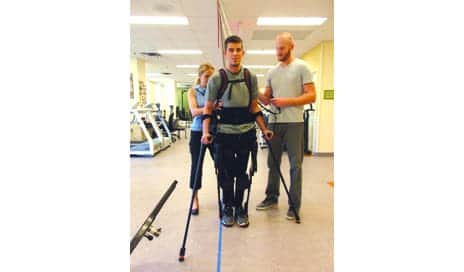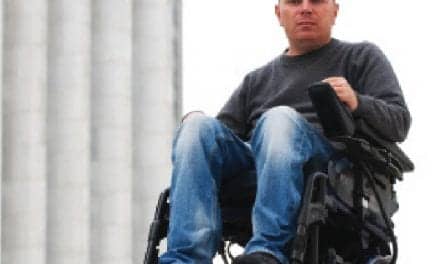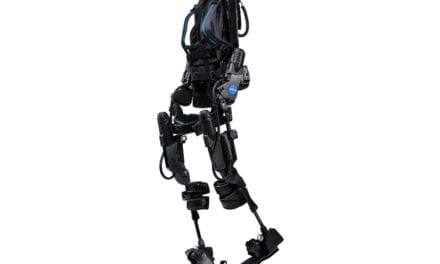
Technology offers individuals affected by physical disabilities newer tools to aid in neurological recovery.
by Rosemarie Battiato, PT, MPT; Dina Mastrogiovanni, OTR/L, ATP; and Elizabeth Watson, PT, DPT, NCS Restoring function is a primary focus of many physical therapy programs, and technologies that rebuild gait and balance are among those crucial to helping patients meet their rehabilitation goals. Though such technologies are common among the stroke population, they have utility among a wide range of patients, including those affected by spinal cord injury, traumatic brain injury, orthopedic conditions, and certain neurological diagnoses. We live in a high-tech age where iPads, cell phones, remote controls, and voice commands obey their users’ wishes. This level of technology has also penetrated the rehabilitation field, where patients are now afforded opportunities that were unavailable 10 years ago. These advances in technology give these individuals more independence, improve their ability to communicate, prevent secondary complications as a result of their injury, and contribute to a better quality of life. This article explores how Magee Rehabilitation Hospital, Philadelphia, applies the rehabilitative benefits of measurement and assessment technologies to rebuild motor function across a varied patient population as those patients move toward discharge. It also spotlights how patients at Magee are trained to use mobile computing technologies that promote independence and prevent secondary complications as a result of injury—ultimately providing a higher quality of living post-discharge.

Smart Room technologies range from remote controls that can operate small electronics to a computer-based system that automates a home.
High-Tech Smart Room for Post-Discharge Living
The Smart Room was created to offer patients an opportunity to observe and test today’s adaptive technology, and discover how they can use it in their own lives. Patients can practice using the equipment themselves to evaluate how it may be able to increase independence and improve quality of life. Individuals with diagnoses such as spinal cord injury, MS, ALS, and CVA are examples of those who could benefit from this level of technology. This equipment can allow individuals to access a computer for communication and education and enable them to control electronic devices such as lights, phones, televisions, and other commonly used home devices. Examples of available equipment are iPads with alternative access options (ie, ability to use a switch to control an iPad) and computers with alternative controllers such as eye gaze, head mouse, touch screen, and voice control. The room is set up to simulate an adapted apartment that has environmental controls to open doors, access security cameras, turn on lights, turn on the television, music, etc. The equipment varies in complexity and ranges from something as simple as a remote control to operate small electronic devices, to a computer-based system that can automate an entire home. “When you’re in rehabilitative therapy, you’re so consumed with your injury that you spend a lot of time thinking about your limitations,” say Dina Mastrogiovanni, OTR/L, A/tP, director of Magee’s Smart Room. “Having an opportunity to see technology in action can shed light at the end of the tunnel. You begin to realize that there are more things you can do than you thought, such as going back to school, having a job, or even living independently.”

Computerized pressure mapping allows visualization of pressure distribution over the entire seating surface and indicates areas of increased pressure.
Pressure Mapping
Computerized pressure mapping is an assessment tool that is used to aid in selection of appropriate wheelchair cushion seating, usually for an individual affected by an injury that has resulted in impaired sensation on the buttocks. It allows the clinician to visualize pressure distribution over the entire seating surface and indicates areas of increased pressure. A mat with sensors is placed under or behind the client, which then sends an image to a tablet with software that can translate this image. This reading shows, with color coding, a three-dimensional grid or numerical array where the areas of increased pressure are located. This can be an important tool to aid in the prevention of decubitus ulcers. Decubitus ulcers can be costly and catastrophic. Each year, more than 2.5 million people in the United States develop pressure ulcers. This tool can help compare seat cushions, mattresses, and back rests so that the clinician can make the most appropriate choice for the patient’s skin protection. It can also be a wonderful educational tool for the client, as it provides a visual representation of how posture and positioning devices can affect pressure.
Body Weight Support
Therapists at Magee Rehabilitation utilize a treadmill and body weight support in the Locomotor Training Program in order to assess and progress a patient’s functional ability related to ambulation, balance, and recovery of the nervous system. When a patient requires upper-extremity support through an assistive device to maintain a standing position or to safely walk, it is difficult for a therapist to determine how much arm support the patient is using to compensate for core and lower-extremity weakness or decreased balance. The body weight support (BWS) treadmill environment provides a means to quantify characteristics, including body weight load and treadmill speed, that reflect recovery necessary for the achievement of standing and walking. During standing activities, the amount of BWS that is required for a patient to complete certain activities can be quantified and progress can be tracked using BWS as a measurement. For example, a patient may require use of a walker and minimal assistance from a therapist to maintain standing balance. A more quantifiable way of assessing this same patient would be to use BWS. In this environment, a therapist can assess how much support is required for a patient to maintain appropriate pelvic position without manual assistance. As a patient’s balance, core, and lower-extremity strength improves, less BWS will be required. Progression of a patient’s recovery is evaluated and progressed using a top down approach, working on gaining independence and control over the trunk first, followed by the pelvic region and then the lower extremities. Once a patient has regained the ability to maintain static standing without manual assistance or BWS, therapists can use this environment to assess the ability to complete higher-level balance tasks, including tandem and single-limb stance, by tracking how much BWS is required to allow a patient to complete a certain task. Recovery of walking is assessed and progressed in a similar manner. An optimal stepping pattern is achieved by adjusting the treadmill speed, BWS, and level of manual assistance. As a patient recovers, that individual will be able to maintain an appropriate stepping pattern with less BWS and at faster speeds, first without manual assistance at trunk, followed by the pelvis, and then the lower extremities. For example, a patient who walks at 2.0 mph with 45% BWS and assistance at the legs shows progress when able to walk at 2.4 mph with 40% BWS. Therapists utilize the treadmill and BWS environment as a safe way to achieve multiple repetitions of task-specific practice of walking with more steps at a faster speed than traditional therapy. The treadmill with BWS provides a permissible environment for treating patients of various diagnoses as well as tracking progress over several sessions.
Exoskeleton
Another type of equipment used at this facility includes a wearable bionic suit designed to allow individuals affected by lower-extremity weakness or paralysis to stand and walk over ground using a reciprocal pattern with full lower-extremity weight bearing. The walking pattern is achieved when the patient shifts weight in the appropriate manner to activate sensors in the device, resulting in steps. Motors at the hip and knee joints power the leg movement in place of decreased leg function. This bionic suit can be used in two primary ways. The robotic exoskeleton allows patients with motor complete spinal cord injuries the opportunity to be upright, benefit from weight bearing on the lower extremities, mobilize his/her joints, and experience the psychosocial aspect of being eye to eye with others. It can also be used with patients affected by motor incomplete spinal cord injuries as well as patients with other neurological injuries, including post stroke, traumatic brain injuries, and multiple sclerosis. Variable assist is a newer feature on this device which allows therapists to challenge those patients with some lower-extremity movement to contribute to the walking pattern. Within the variable assist feature, the adaptive assist mode means patients use leg strength to produce a walking pattern and the exoskeleton dynamically adjusts how much power it needs to contribute to achieve a smooth walking pattern. Immediate feedback is available to the therapist about the amount of power the device needs to use at each leg for the patient to complete each step within the specified time frame. As a patient relearns the appropriate gait pattern, the amount of power required decreases. Progress can be tracked on each leg individually using the power levels provided. In the fixed assist mode, therapists can assign a specific amount of power that the bionic suit utilizes to assist with the movement pattern. The power value assigned is determined using information obtained when the patient walked in adaptive assist mode. As patients progress through the recovery process, therapists can continue to challenge them by decreasing the power value in the fixed assist mode, requiring the patient to increase his/her effort to maintain a normal gait pattern. Technology not only helps society with instantaneous communication, it also offers individuals with disabilities newer tools to aid in neurological recovery. These cutting-edge advances in technology give patients the hope of reaching their goals in a way that was not available 5 to 10 years ago. Additionally, this technology is rapidly changing through advances that create lighter or more streamlined equipment. Research and development continues to offer opportunities to make the once impossible, possible for those patients we have the privilege to serve. RM Rosemarie Battiato, PT, MPT, is director of outpatient development and programs, Magee Rehabilitation Hospital, Philadelphia. Dina Mastrogiovanni, OTR/L, ATP, is an advanced clinician and director of Smart Room, Magee Rehabilitation Hospital, Philadelphia. Elizabeth Watson, PT, DPT, NCS, is locomotor training clinic supervisor, Magee Rehab-ilitation Hospital, Philadelphia. For more information, contact [email protected].






